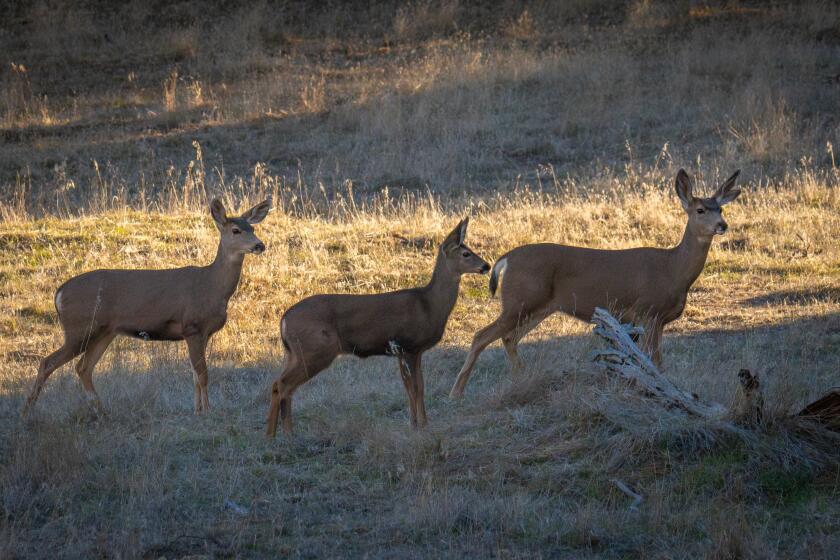Llamas Try an Image Make-Over
Llama folks are just a teeny bit paranoid about spit.
It’s not, you understand, that they fear they’ll get spat on. No, their worry is this: that when Americans think llama, they will also think spit.
This is not an irrational fear. Because the fact is, llamas do spit. To be fair, though, they usually aim at other llamas. It’s a dominance thing. A way to call first dibs on the hay. And only if provoked will they propel their phlegm at people.
Yet such details tend to be lost on the masses.
That is why llama folks are extraordinarily sensitive about the subject--especially now, when they are struggling to forge a market for clothing made from llama wool. It seems some high-fashion designers just aren’t interested in scarfs and shawls and sweaters made from an animal that spits.
“There’s a stigma about llamas,” said Virginia Vogel, a Vermont rancher and garment designer who is peddling $100 llama fleece vests. “They spit, they’re beasts of burden--that’s what people say. We have to break the stigma.”
In fact, llamas have come a long way from the popular image of gallumphing pack animals with scratchy coats.
In their native South America, llamas carry salt, grain and crops through the Andes; they are valued for strength and durability. And, yes, their coats are rough. In North America, however, llamas are prized as aristocratic show animals--and bred to have soft, flowing wool.
Though llamas have been raised in the United States for years--starting, legend has it, at William Randolph Hearst’s San Simeon estate--they vaulted to super-chic status only in the mid-1980s.
Celebrities such as singer Michael Jackson and actress Kim Novak began collecting them as pets. A Nebraska livestock breeder spread the craze with a much-publicized auction of imported Bolivian llamas. The Wall Street Journal followed up in 1984 with a trend-in-the-making article that teased: “Some Call Llamas the Cat’s Pajamas, But Will They Sell?”
The answer, most emphatically, was yes.
In the last 13 years, the llama stock in the United States and Canada has exploded from 7,000 to more than 118,000, with the heaviest concentrations in California and Oregon. For a time, there were even waiting lists to buy llamas.
“They just kept getting more glamorous and more glamorous,” said Jo Ann McGrath, editor of Llama Life magazine. “A lot of wealthy people bought them.”
They bought them not as pets, but as investments--like artwork, only better, because they multiplied.
Every year, a mama llama could be counted on to give birth. The baby, or cria, could fetch $6,000 or more before it was even weaned. Mature females with a breeding history sold for $40,000 to $60,000 or more, said Sandy Chapman, general manager of the Denver-based International Llama Assn.
Champion males with thick woolly coats, sterling pedigrees and first-place show ribbons cost even more. As the llama frenzy intensified, some males went for fabulous sums--$190,000 or more. Owners could make back their investment by charging stud fees of up to $5,000.
To push up prices even more, llama ranchers mated the most poofy animals together to produce ever-more-cuddly offspring--the kind most honored at shows. Thanks to this selective breeding, many of today’s llamas have silky coats almost as fine as cashmere.
“You put a llama scarf around your neck and it’s just as soft as feathers,” Granada Hills llama breeder Rebecca Lowe boasts.
Even with these advances, American llama ranchers did little to promote their animals’ wool until recently. They had no need. The market for llamas was so hot they could make money just by breeding and selling the babies.
“The price of llamas was so astoundingly high for a while that a lot of people didn’t care about developing an end use for them. They were investing in them only to crank out more llamas,” said Sandy Mubarak, who raises 80 llamas on her Poway ranch.
Then, inevitably, the bubble burst.
In the early 1990s “we had, as the stock market would say, a correction,” Chapman said.
The cause was clear: All that frenzied breeding had produced so many llamas that supply outstripped demand. Prices flopped. Llamas that had once sold for six-figure sums were lucky to fetch $40,000. And ranchers with llamas on their hands began looking for other ways to make money.
As Maryan Baker, president of the Llama Assn. of Southern California, put it: “They’re cute and I love ‘em, but it’s nice to have something profitable off them.”
Some enterprising souls collected llama dung--which is remarkably compact and stench-free--and marketed it for fertilizer as “llamanure.” Others moved into “llamabilia,” selling llama knickknacks like furry stuffed toys. A few set up llama-themed bed and breakfasts and began offering llama treks, in which families could load their gear on llamas and guide the animals on hikes.
But the most promising industry seemed to be fiber.
After all, wool from alpacas--a stockier, shaggier cousin of the llama--was eminently fashionable. Camel hair was equally swank. So why not llama?
The wool was already popular among hand-spinners and weavers, who made everything from socks to Santa Claus beards. It comes in a dozen natural colors: beige and chocolate, cream and ink, silver and a bronze-flecked red.
Plus, shearing was suddenly in vogue, as ranchers realized that overly woolly llamas were vulnerable to heatstroke. All across the country, ranchers were sweeping giant piles of fiber into paper bags and stashing them in their garages.
It seemed an apt time to pump up llama wool from cottage industry to commercial enterprise. “There’s a lot of potential there,” Baker said.
But there are several pitfalls as well.
First off, llamas do not produce vast quantities of fiber. They have been bred to be fluffy, sure, but most yield just three to five pounds of raw wool a year, enough for five vests or two sweaters. And many llamas bristle with guard hair--a coarse, protective coat that must be plucked by hand after shearing.
Also, since most commercial mills require orders of at least 200 pounds, ranchers must pool resources to get their fiber spun into yarn.
Then there’s the question of the the llama’s image.
Its spitting image, so to speak.
“We have to keep fighting that all the time,” Baker said, sounding mighty weary of the topic. “Everyone keeps asking, ‘Do they spit? Do they spit?’ ”
Well, maybe not everyone.
Los Angeles-based fashion designer Carole Little, for one, said she has always thought of llama as “soft and expensive,” as “a pretty animal,” not a plodding one. True, she had never really thought about using llama in her line. But when asked about it last week, she said the idea intrigues her, especially if the price is right. “I always want to look at something new,” she said.
Despite those encouraging words, llama partisans gripe about a general perception that llamas are louts. The stereotype, it seems, spills over into a notion that llama wool must also be crude.
Tennessee artisan Melissa Tallent, who makes llama garments, said that before customers get a close look, they tend to think of llama wool as “coarse and rough,” good mainly for saddle blankets, baskets and rugs. “Something you want to walk on, not have next to your skin,” she said.
That bad rap, Oregon rancher Sue Panos said, “can take a lot to overcome.”
Panos should know. She once maligned llamas herself. And she has a fair idea where they got their churlish reputation: children’s petting zoos, where llamas, frightened and besieged, tend to let fly with all their bad habits.
“One came up to me there when I was a kid, sniffed my ear and spit on me,” she said. After that sliming, Panos steered clear of llamas for decades.
Then one day she came across Tree Breeze Farm in Central Point, Ore.--and saw a herd of sweet-tempered, non-spitting llamas lazing in a sun-splashed pasture.
She was enchanted.
These llamas weren’t anything like the nasty, put-upon creature she remembered from the zoo. These llamas looked dignified, majestic even. Yet they looked fun too, their regal bearing undercut by their feather-duster tails and their tufted banana-shaped ears.
Their owner, Dorothy Steinhoefel, could call the llamas with a gentle coo of: “C’mon babies, c’mon girls.” Looking like a pack of animated mops, they would prance across the field at Steinhoefel’s call, shaggy hair bouncing at every step. They nuzzled her neck, nibbled her buttons, played with her dog and kissed her on the mouth.
Panos fell in love.
She bought one, then another, then a third. Now she boasts a herd of eight llamas and five alpacas.
“I was having lunches and shopping . . . and now I’m moving manure from one place to the next and I never have time to go shopping unless it’s to the grange, Costco or Wal Mart,” Panos said in wonder. “I’m dead tired, but it’s fun.”
Llamas tend to inspire that kind of devotion. Which is why breeders are so convinced their wool will make it big. If the public learns how winning llamas are, ranchers reason, they will want to be near them--and their wool.
All it will take, they say, is a little education and a lot of exposure.
“What we have to do as an industry is put out the word,” Connecticut rancher Kate Bars said.
On a mission to promote llama products, Bars’ Hindsight Farm buys raw wool from across the country, up to 2,500 pounds a year. She sends it to a mill for processing and turns it into winter coats, velvet-lined capes and other garments.
Bars pays $5 a pound for llama fiber--considerably higher than the going rate for sheep’s wool, which is well under $1 a pound. When processed into fabric, llama sells for $30 to $35 a yard, twice as much as sheep’s wool but less than half the price of cashmere, said Lewis Crothers, plant manager at the L.W. Packard Mill in Ashland, N.H.
“It’s a great cloth,” Crothers said. “It feels rich, it feels luxurious, it belies everything you’ve thought about llama in the past.”
But for all his enthusiasm, Crothers was unable to sell any designers on llama during a recent sales swing through New York. “It hasn’t met with great approval,” he said. Undaunted, Crothers plans to rev up his sales pitch and try again soon.
Llama, he’s convinced, will be the next fashion fabric.
In the meantime, publicity can only help the llama boosters’ cause. Still, they are leery that any article might reinforce bad stereotypes.
“Please,” one llama rancher begged, “do not put anywhere in there that they spit.”
Another commanded: “Do not mention spit in anything you write.”
Not everyone, of course, is quite so spit-shy.
Baker points out that her llamas are loyal, good with kids and so smart she can train them to run an obstacle course. Given those positive traits, she said, she doesn’t worry about the spit factor tainting the llama’s image forever.
“My god,” she said, “if that’s the worst thing an animal can do to you. . . . “
(BEGIN TEXT OF INFOBOX / INFOGRAPHIC)
All About Llamas
Llamas, members of the camel family, are native to South America but have been raised in the United States for decades. Some basic information about llamas:
* They live for 15 to 25 years
* A pack llama can be purchased for less than $1,000. A champion stud can cost $50,000 or more.
* They communicate by humming and with their tail, ear and body posture.
* They get most of their nutrients by grazing. One acre of pasture can feed three to five llamas.
* They are relatively inexpensive to raise. Unlike horses, they do not need to be shod. They do not need shelter except in the worst storms. They are hardy animals and require minimal veterinary care.
* Female llamas can be bred at any time, as they ovulate after mating. Pregnancies last 11 1/2 months.
* Babies, known as crias, weigh up to 35 pounds at birth. Mature llamas average 280 to 350 pounds.
* The animals love water, and will soak in wading ponds on hot days. They also enjoy rolling in dirt.
* They can carry up to 100 pounds and can be trained to pull carts.
* They have two-toed, padded feet that let them walk over difficult terrain without destroying vegetation. They have no top teeth and are incapable of licking.
* Theft is not a big problem because the animals are nearly worthless without registration papers. Many are insured in case of untimely death or infertility.
Source: International Llama Assn.
More to Read
Start your day right
Sign up for Essential California for news, features and recommendations from the L.A. Times and beyond in your inbox six days a week.
You may occasionally receive promotional content from the Los Angeles Times.






